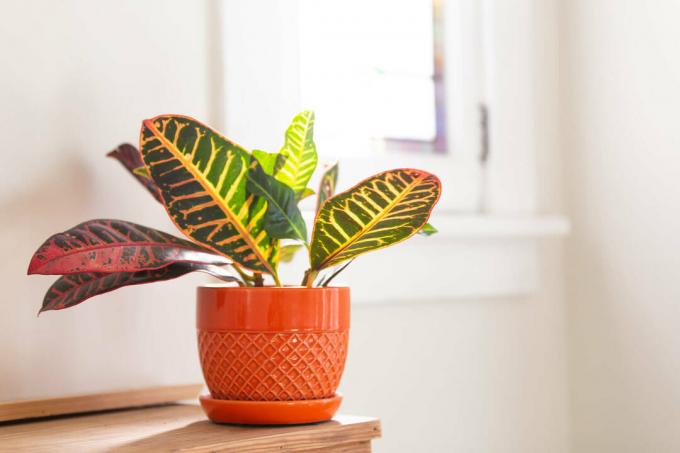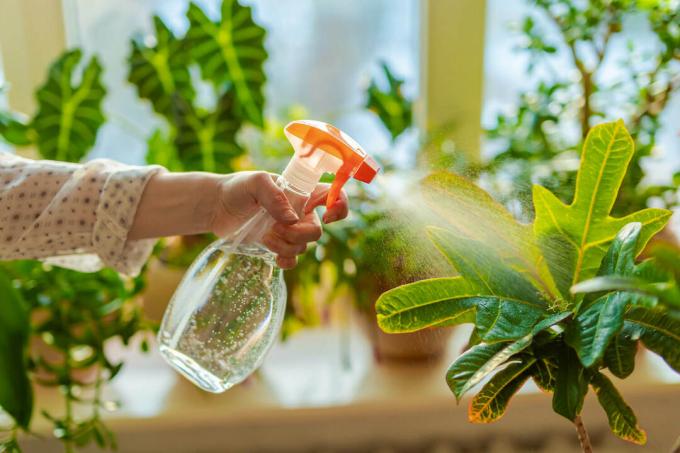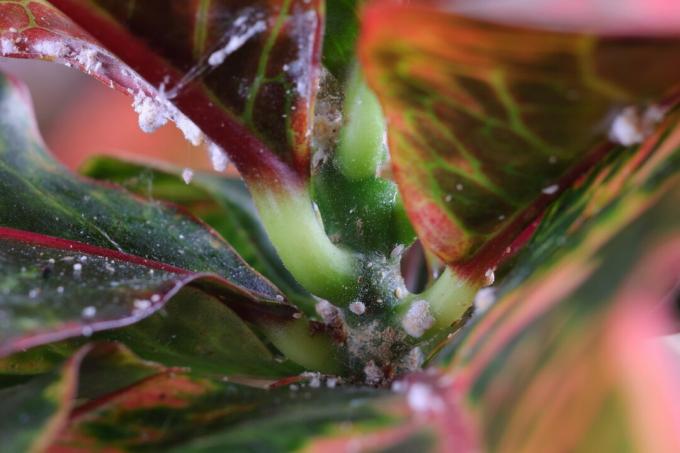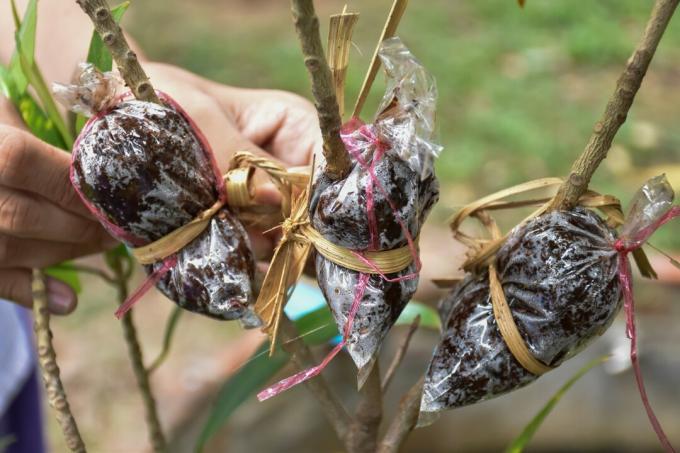With its brightly colored leaves, the croton seems almost unnatural. Despite its extravagance, the miracle shrub is easy to handle in terms of care and location.

The croton owes its synonym "miracle shrub" to the variety of colors of its leaves. We give tips on how to pot, care for and propagate this special shrub.
contents
- Croton: flower, origin and properties
- The most beautiful species and varieties of the miracle shrub
- Plant croton: location, soil and Co.
-
Croton care: the most important measures
- Fertilize, water and cut
- Miracle shrub loses leaves: why is it?
- multiply croton
- Is the miracle shrub poisonous?
Croton: flower, origin and properties
The Miracle Bush (Codiaeum variegated), which is often still traded under the older name Croton, has its origins in Southeast Asia, especially in India and Indonesia. There, the spurge (Euphorbiaceae) thrives in tropical forests. The croton always grows upright and has evergreen sword-shaped leaves that also shine in other colors depending on the light intensity: yellow, orange, red or purple are often found. There are significant variations between the different varieties bred. In the wild, the wild form of the shrub grows up to two meters high. Flowers rarely appear on croton in indoor culture. If it does, then the white flowers form from the upper leaf axils and are arranged in small racemes.

The most beautiful species and varieties of the miracle shrub
The varieties of croton differ both in the shape of the leaves and in the variation of the color palette. The following beautiful varieties are available commercially - the ornamental plants usually belong to the variant Codiaeum variegated var. pictum at.
- C variegatedum 'Petra': Leathery, heavily veined leaves of branched mainwood
- C variegatum 'patient': Broad, yellow-orange leaves
- C variegatum 'Aucubafolia': Glossy leaves with yellow spots
- C variegatedum 'Norma': Oak-like leaves with red veins
- C variegatum 'Van Ostensee': Narrow, yellow-green mottled leaves

Plant croton: location, soil and Co.
The miracle shrub needs a spot indoors with plenty of indirect sunlight, but never direct sunlight, otherwise the leaves may fade. Depending on how bright its location is, the color of the croton varies. The more light, the more color variation the plant shows. The tropical plant likes high humidity. However, drafts or room temperatures below 18 °C should be avoided. In winter, a place with an ambient temperature of around 16 °C is sufficient for the croton.

A suitable soil should be able to store a lot of water. At the same time, however, it should not collapse after a short time, otherwise root rot will easily occur. This property is achieved through the use of coconut pulp, which has a particularly favorable ratio of water and air capacity. Our Plantura organic universal soil for example, consists to a large extent of coconut pith, contains no peat, but instead compost in order to be able to store and provide nutrients in the long term. A drainage layer at the bottom of the pot ensures good water drainage - you can use expanded clay balls or pebbles for this, for example.
Hydroculture is also possible for the miracle shrub so that it does not have to be watered too often. In this case, watering once a week is sufficient.
Croton care: the most important measures
For such a beautiful plant, which also bears the name "miracle shrub", the croton has surprisingly few requirements.

Fertilize, water and cut
In the summer months you can fertilize the croton weekly in small doses, while in the winter time a monthly dose of fertilizer is sufficient. A potassium-rich liquid fertilizer is suitable for this, which ensures a firm and resistant cell structure. For example, our primarily organic Plantura organic indoor and green plant fertilizer enables such plant nutrition. The microorganisms contained also support root growth.
You should also water the miracle shrub abundantly in summer, the soil should always be kept moist. In addition, the croton likes high humidity - for this you can often spray the croton with soft water and often wipe the leaves with a damp cloth.
A cut is not necessary in principle, but you can cut off individual shoots to influence the shape, if this is desired. The best time for this is in autumn at the end of the growing season. When the shoots are cut off, a lot of milky sap escapes, which is irritating to the skin and poisonous. Therefore, you should wear gloves when doing this.
If the whole root ball is rooted through or the soil has collapsed and is no longer able to absorb water, it is time to repot. A rule of thumb is: repotting every two years. Also an indicator is noticeably inhibited growth and the need for constant watering. The best season for repotting is spring. Because then the shrub forms new roots in order to start growing and thus survives repotting best. The new pot should be about 20% larger than the old one. It also makes sense to provide the miracle shrub with an organic long-term fertilizer when repotting to provide trace elements and phosphorus. For example, ours Plantura organic universal fertilizer usable, which contains no animal components and therefore does not spread an unpleasant odor in the apartment.
Broken bricks or gravel are the best drainage layers to prevent root rot.

Miracle shrub loses leaves: why is it?
If the croton sheds leaves, this indicates faulty care. We have listed some possible reasons below:
- Too cool location: The comfortable temperature of the croton is 12 - 20°C.
- Too dry: The miracle shrub thrives best if the substrate never dries out completely and the leaves are frequently sprayed wet.
- Too dark: An optimal location for the croton is about 2-3 meters from the window where it will receive 5 hours of indirect sunlight.
- Nutrient deficiency: Fertilize regularly and repot every 2 years.
- infestation with spider mites or thrips: Happens especially when the culture is too warm and too dry; therefore keep wetter and cooler after treatment.

Tip: You can fight thrips on croton, for example, with our biological pesticide against biting and sucking insects. Our Plantura Organic Pest Free Neem is gentle on beneficial insects and easy to use. When using, please always observe the instructions in the application recommendation.
multiply croton
The colorful croton can be propagated by yourself. This is possible via mosses, leaf cuttings or shoots or head cuttings. The easiest way to propagate is through cuttings:
- A fresh, healthy and vigorous shoot with about two young leaves in early spring Cut off and first place in a glass with water for rooting or directly in moist soil put.
- The wound can be treated with charcoal powder to stop the discharge.
- Put the cuttings in a loose and nutrient-poor soil. Rooting is often successful in simple garden soil mixed with sand. Ours, on the other hand, is optimal and germ-free Plantura organic seed and herb soil. Since it is steamed, the cuttings remain healthy and the addition of perlite also ensures good ventilation at the base of the stem, which has been proven to facilitate rooting.
- It is important that the soil is kept warm and moist. In addition, the glass with the offshoot should be placed in a warm place.
- Roots develop well at temperatures between 22 and 30 °C.
- It is a good idea to build a small greenhouse for the offshoot by putting a bag over it - this keeps the humidity high on the cutting.

Is the miracle shrub poisonous?
Like other spurge plants, the croton contains plant milk, which is slightly toxic and therefore irritates the skin and mucous membranes. Consuming it causes gastrointestinal problems.
The following symptoms of poisoning occur in dogs, cats, birds and rodents: severe irritation of the mucous membranes, salivation, vomiting and diarrhea.
Are you enthusiastic about colorful houseplants? Then take a look at our article about the basket marante (calathea) past.



